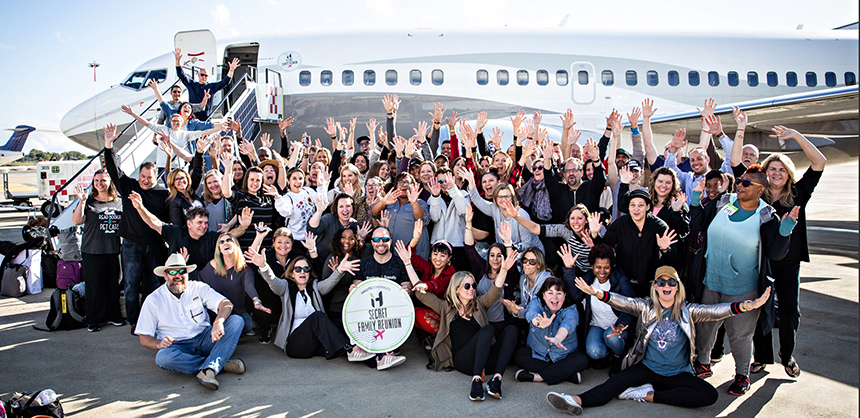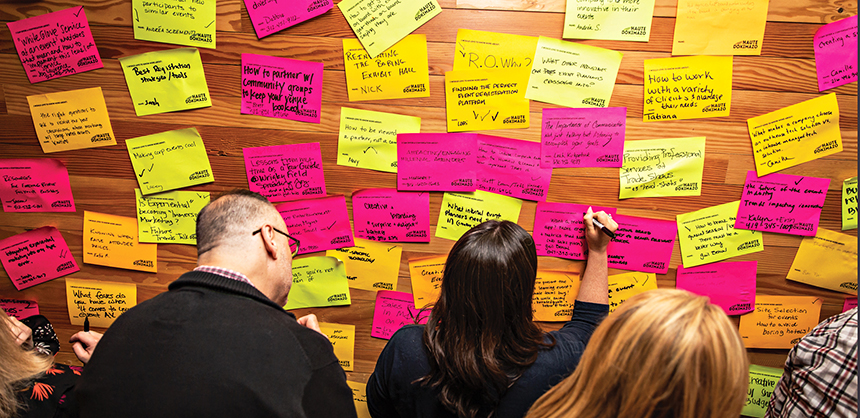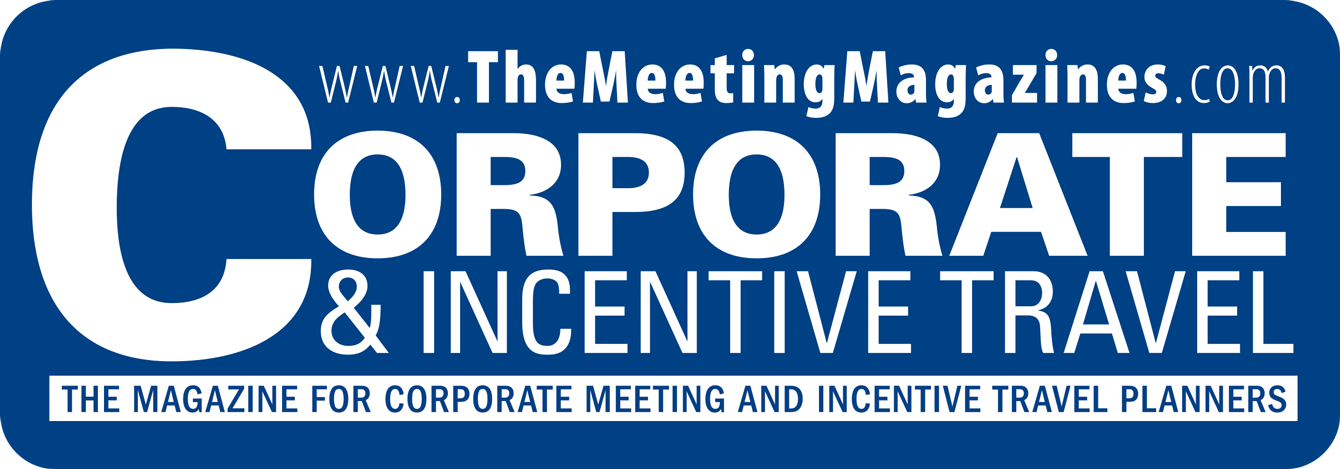Budget BeatersJune 24, 2020
Innovation & Inspiration Under A Tight Spending Plan By Maura KellerBudget Beaters
Innovation & Inspiration Under A Tight Spending Plan
Liz Lathan, CMP, CEO of Haute Dokimazo, which hosts an annual Secret Family Reunion, below, says of proper budgeting, “It’s imperative to make every dollar you spend have a direct impact.” Courtesy of Liz Lathan
It was only a few months ago when corporate spending gave meeting and event professionals the proverbial blank check when it came to orchestrating a corporate affair. No longer. Nowadays, with the threat of COVID-19, businesses and their hired hands are abiding by a more restrictive code of conduct and recognizing the need to get the most “bang for their event buck” — all while creating innovative and inspirational events.
Liz Lathan, CMP, chief experience officer at Haute Dokimazo, says although budgets may be tighter, the pipeline and revenue goals are not. “In light of reduced marketing budgets, it’s imperative to make every dollar you spend have a direct impact on the pipeline you are driving with those dollars,” Lathan says. “Ensuring events and experiential activations are at or below budget will ensure that you can continue to get funding.” And while cost-conscious innovative event ideas can be incorporated into the majority of meeting and events, embracing key budgetary measures can help those innovative ideas stretch further.
Budgetary Basics
As we’ve seen, meeting and event costs, the one line item that can make a CEO cringe and raise eyebrows in meetings, is under greater scrutiny today. As large corporations and small businesses alike continue to fight for success in a suddenly sputtering economy, the focus on the bottom line has forced companies to re-evaluate the way money is spent. Increased scrutiny on corporate expenses has placed a tremendous amount of pressure on meeting professionals to show clear evidence those meetings and events are indeed valuable to a company.
As Caytie Pohlen-LaClare, founder and president of The LaClare Group Inc., explains, there are some common budgeting mistakes of which meeting planners need to be aware:
Mistake #1 — Not completing the budget process. Create a working budget, with one column for the initial budget projections and another column for the “actual” expenses as they begin to take form. When used correctly, the working budget will help identify any shortfalls or potential problems before they get out of hand.
“Numbers are your friend, and you need them to make the best decisions and course-corrections along the way,” Pohlen-LaClare says. “I prefer to overestimate on expenses, and under-estimate on revenue. This approach allows my team to successfully achieve budget projections for clients. Nobody wants to go over budget.”
Mistake #2 — Forgetting to add in all the taxes and service charges/gratuities for food and beverage, sleeping rooms and other goods/services. Remember to add in travel agent booking fees if you use an agency to purchase airfare.
Mistake #3 — Not keeping a full, detailed list of all revenue streams and all expenses.
Mistake #4 — Forgetting to update the budget if the number of participants changes. This is especially important if participant numbers increase.
Mistake #5 — When you calculate the F&B, spend the time to calculate the actual costs based on menu items selected for all meals, breaks, etc., plus any additional expenses, such as bartender fees or carving station chef fees; the various taxes, such as food, liquor, etc.; and the service charges, which usually are 19% to 23%. Forgetting to do this could mean under-estimating the F&B costs by 25% or more.
“We had a client who used the F&B minimum listed in the contract instead of the actual F&B cost estimates and it was a difference of over $30,000,” Pohlen-LaClare says. “After we were brought in and did a full budget for them, we had to give them the bad news of their underestimate.”
To truly embrace the innovative and inspirational aspects of what can be done on a limited budget, Lathan advises meeting planners to read the contracts, negotiate bulk deals and ensure the money is going toward impactful items. “If you have hired outside support from A/V vendors or suppliers, ensure their travel and expenses are included in the quote so the final billing does not surprise you,” Lathan says. “And make sure you know the attrition, cancellation, and tax and gratuity clauses on the hotel/venue contracts.”
And if a meeting planner has a series of events, or knows the road map for upcoming events, work with a set of suppliers to get a bulk or bundled discount. Also set up events to be “rinse and repeat.” If a planner has an event series, Lathan suggests working with a single hotel or event venue brand to make planning easier and to get better pricing. “Ensure the money is going toward impactful items,” Lathan says. “Don’t plan for cheap, random trade show giveaways.” Look for higher-quality items that deliver the message and only give them out to qualified leads. Try cutting back to just 10% of total attendees, so just 100 giveaways for a conference of 1,000.
Also, Lathan says it’s important to only invest in sponsorships that make sense. A lanyard sponsorship might not get the message out as it does not come with a clear call to action. “Aim for sponsorships that will either drive people to a booth, to a session or to a website,” Lathan says. “Also do pre-event marketing to target audiences to drive awareness. If the conference won’t share attendee info, but a company attended last year, take the leads from the previous year and run an email campaign to get people to the booth or sessions.”
For Larisa Draves, CMP, president at Draves & Associates, budget planning is vital for meetings and events, especially in light of today’s economy — but it doesn’t have to mean an event has to be a drab, boring affair. As Draves explains, budgeting is part of a larger overall goal-setting plan for any event or conference. “In light of the current economic situation, I think budgets will be highly scrutinized for quite some time and are a very important part of tracking goals,” Draves says.
If possible, Draves recommends reviewing historical data from previous years as it’s helpful to provide benchmark data. If you don’t have data readily accessible, a meeting planner can usually obtain it from the vendor, e.g. caterer or hotel. “I think being forthcoming with the client is important. Often the client doesn’t realize what things cost. For example, one of my clients saw a catering display they thought was attractive, but they didn’t realize it was a custom-built display and the client paid extra money for the display to be built, etc.,” Draves says.
When possible, Draves always tries to find local vendors — a local entertainer, a florist or perhaps using an area artist to make centerpieces or decorations. “I think most planners keep a log of ideas or active Pinterest pages so you have some fun ‘go-to’ ideas ready for the client,” Draves says. “I also think watching trends is important. Offering healthy food options doesn’t have to be costly either. Some groups really appreciate the small gestures like offering fruit-infused water at a break and limiting the sodas and unhealthy snacks. And offering fruit and other natural foods for snacks instead of processed foods can also save money.”
Lathan also advises that companies do fewer, more impactful events. “Start with getting an event road map all on one spreadsheet so you can see how many events an organization or company is running and in what cities,” Lathan says. “If you find overlap on field events in the same cities, consider consolidating the events or running them back-to-back in the same venue to leverage the branding.”
Also, rather than doing so many field events and small trade shows, meeting planners can advise their clients to focus on running ancillary events at industry conferences where the audience already congregates. “A company can also do more, cheaper regional events,” Lathan says. “Evaluate the pipeline goals and consider not going to large-scale industry conferences for large sums of money, and instead run smaller local events to connect on a more personal level with customers and prospects.”

Experts agree that good planning and teamwork result in excellent outcomes, even with tight budgets. Courtesy of Liz Lathan
Affordable, Innovative Event Elements
Bryan Mattimore, co-founder and “chief idea guy” at Growth Engine Innovation Agency, recently facilitated a session for business leaders in Connecticut as part of an eight-session program to “help develop community leaders.” Mattimore’s agency is based in Westport, Connecticut. He’s written three books on ideation and innovation processes and has personally planned and conducted more than 1,000 client meetings/teambuilding exercises.
This particular unique meeting idea involved having seven teams of seven participants each create a collage of their perceptions of Fairfield County, Connecticut. They passed out hundreds of visually oriented magazines — collected from the sponsoring organization, the Business Council of Fairfield County and the local library.
“All the magazines were free,” Mattimore says. “Our only expense: We provided large posters, scissors and glue sticks so the teams could construct their collages.” The instructions to the teams were to rip out any picture, word or phrase that reflects the essence of Fairfield County. They were asked to make sure to capture perceptions of all facets of society: business, education, government, healthcare, leisure, cultural, ethnic diversity, etc. Then, they were asked to arrange what they ripped out on the posters to create a collage. When they were done arranging and gluing, each team presented their completed collage to the group as a whole.
“The exercise was a big hit,” Mattimore says. “It was a fun and easy, and a quick way for the attendees to get to know one another — and garner some insight into their current perceptions of Fairfield County.” At the end of the meeting, Mattimore and his team collect the collages, and when the eight-session program is completed, he says, they have the teams revisit their collages to see how their perceptions of Fairfield County have changed.
As Mattimore explains this collaging technique can be used in small, medium and even large group meetings to gain insights into a wide variety of business challenges, i.e. to assess employee perceptions of the company’s culture, the current competitive environment, areas/opportunities for growth/innovation and customer experience.
At a different event, Mattimore orchestrated a “Junk Jamming” session, whereby 20 teams of eight people at Unilever did a “junk jam,” a teambuilding exercise where music was made from “junk,” such as discarded metal cans, hubcaps, soda cans, bottles, wooden planks and more. “The business principle we were invoking/reinforcing with the exercise is that you can do more with less in the marketing and promotion of your brands — as long as you add creativity to the mix, and the answer is often right in front of you if you have the eyes/creativity to see it,” Mattimore says.
Mattimore also conducted a war-gaming session with 50 executives from a large insurance company. He had seven teams role play seven competitors, not only obvious industry competitors, but potential industry disruptors as well. He explains, “The seven teams had great fun first building their own company strategies. Then, in the afternoon, everyone at the meeting came out of their competitive-company role plays to generate innovative new ideas to combat the potential competitive incursions from Amazon or Google, or Walmart.”
Lathan also recommends exploring innovative ideas that really cost next to nothing. “Meeting planners and the companies they work with should embrace the unconventional as part of their innovative budget planning,” Lathan says. “For example, bring in an engaging new format to break up the monotony of ‘sit-and-get’ sessions. These types of events create community, endearing customers and prospects to a company, and building deeper connections with them, while uncovering their business challenges that will directly grow a company’s pipeline.”
Activities and events aside, Lathan stresses that the most cost-effective and impactful element a meeting planner can add to any event is time. Attendees come to events to meet, share and learn. Help them do that by giving them more time with more people. “Longer coffee breaks give people time to check email so they can make it to the evening events on time but then plan those conference dinners better for networking,” Lathan says. Skip the loud band where people can only talk to the one person on either side of them, and opt for smaller rectangular tables and music that is loud enough to enjoy, but quiet enough that people don’t have to yell at each other.
“Also, create peer-to-peer sessions where participants can discuss topics of interest and share solutions,” Lathan says. “Create a physical problem/solution-focused message board by adding a roll of corkboard to a wall and have participants add things to it throughout the conference.”
And while success of incorporating cost-conscious innovative elements can be measured by the responses of attendees, it is also vital to keep ROI top of mind. In fact, this is true for any event — low cost or extravagant alike. Here’s why: Events are both significant opportunities to enhance relationships with the attendees as well as significant financial investments. Gaining insight into the event characteristics that drive progress against the objectives provides event managers with specific, actionable recommendations on where to best focus that investment.
As Pohlen-LaClare explains, each meeting or event may have a different measurement of ROI. So before holding a meeting, it’s important to discuss and be very clear on what the meeting objectives are and how ROI will be measured. “If a meeting’s objective is to be a revenue generator for an organization, but the budget shows lower revenue, that data can assist with future decisions,” Pohlen-LaClare says. “An accurate budget will show where there were shortfalls in income, and overages in time and expenses. This review process will help inform better decisions in the future.” C&IT









